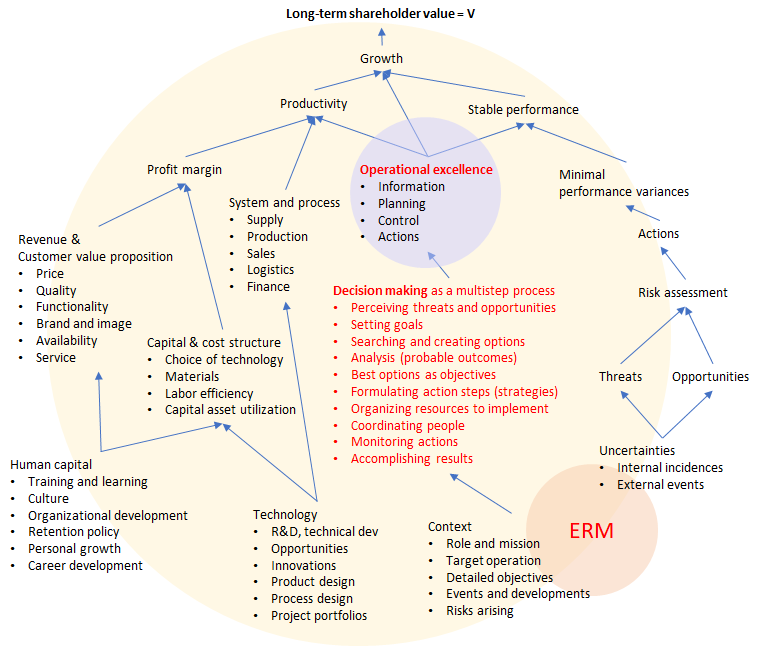 |
|
||||||||||||||||||||||||||||||||||||||||||||||||||||||||||||||||||||||||||||||

|
 Notes of JFU CPA, Tax Advisors, and Digital Tools are prepared for sharing our thoughts on problems encountered in the course of our practice. Subscription is free. Questions and comments are welcome; feel free to write to the Editor, JFU Notes, enquiries@jfuconsultants.com ERM and Governance Excellence with AI-assisted Tools (Part 1)
Getting The Context Right Source : JFU | PONDARA AI Digital Tools
4 August 2023
The primary goal of a firm in business is to grow or increase in value over time. With this premise in mind, business strategy concerns itself with matching unique capabilities to opportunities and even capitalising on threats to create the best value This article is the first of three that focuses on people working together in enterprise risk management (ERM) and in achieving operational excellence. Readers will be invited to explore the benefits of using AI-assisted tools to aid in this endeavour using our “Playgrounds”. The Playgrounds can also be used to facilitate roleplays in management training or workshops.
Operational excellence Operational excellence, or supremacy (for those who view business as a contest), refers to a firm’s possession of superior decision-making capabilities. This is a multistep process that involves perceiving threats and opportunities, analysing options, identifying objectives, formulating steps, organising resources, coordinating people, and monitoring efforts in the execution of practical steps to accomplish results. Systems that automate business process contribute to improving operational effectiveness and efficiency, but it is ultimately people who make decisions, control the systems, and execute actions that determine the final outcome. Operational excellence is thus vested in the people undertaking different roles and functions that truly matter.
What matters The growth goal aligns well with the interests of all stakeholders, both within and outside a firm, particularly concerning long-term shareholder value. According to the enterprise value function, two primary factors drive value and, consequently, growth: productivity and risk. Enhancing productivity and risk management benefits a firm’s long-term value, making all direct and indirect factors that contribute to improvements in these aspects crucial. To avoid excessive use of mathematical notations, Exhibit 1 depicts key factors derived from the enterprise value function, which encompasses the profit and the risk functions. Profit serves as the main source of free cash flows while risk or performance variance determines the discount rate. Both are key drivers in the value function, but value change is more sensitive to risk than profit. Therefore, a firm seeking quality growth must prioritise ERM. Real-life examples that confirm this theory are ample, including the recent SVB collapse The diagram highlights the fact that every decision-maker must think in the context of their role and the mission to be accomplished. They need to consider the actions required to achieve the operational goals and the risks that may arise in the circumstances, which may benefit or hinder the mission. These are complex deliberations, particularly in situations involving uncertainties and other people making moves in collaboration or in competition with the decision-maker.
Exhibit I
Playgrounds (Roleplay Workshops) We now invite you to our “playgrounds” where you can explore how our AI-assisted tools can help you target goals and identify risks. The tools in the playgrounds are part of our IPC-ERM systems, which allow users to manage information, planning, control and enterprise risks in a multiparty strategic situation, typical in both collaborative and competitive games. There are three playgrounds available for you to visit: (1) Context, (2) Objectives, and (3) Risks. This article presents the first playground, which enables you to precisely define your operational context: roles, duties, and target operations required to accomplish your mission. For this initial exploration, imagine you hold a specific role, such as a production manager, a finance manager of a listed group, or the chairman of a nonprofit medical organisation. You are most welcome to use your actual role to experience how AI can assist in real-life situations. Here is a set of brief instructions for your attempt:
Bon voyage in your exploration! Please note that describing your business or operational context can be a challenging task. The absence of clarity could lead to misguided goals and actions. On the contrary, clarity would pave the way for targeting more relevant goals and discerning threats and opportunities that may benefit or derail your mission. These subjects will be further explored in articles to follow soon.
1 Read article - Charting Growth |
 Please contact the authors for any comments or inquiries
Authors
|










